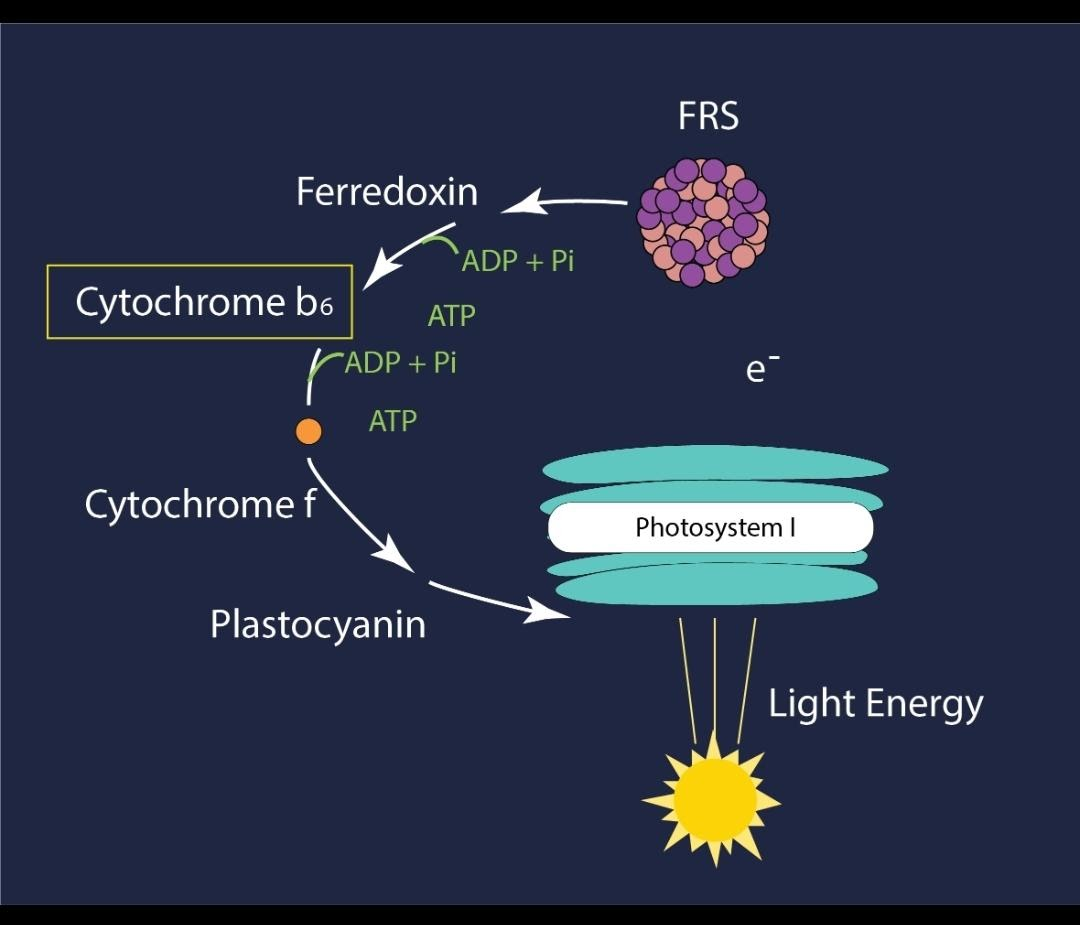
Which is the last electron acceptor in cyclic photophosphorylation?
a. Plastoquinone
b. Plastocyanin
c. Reaction center of PS1
d. None of the above
Answer
424.5k+ views
Hint: Cyclic photophosphorylation is a cyclical process leading to the moment of electrons. On the thylakoid membrane surface to the stromal side, PS1 is present. The first donor of electrons is water and oxygen as a waste product is produced in oxygen photosynthesis. Different electron donors are used in anoxygenic photosynthesis.
Complete answer:
The electrons are released if the PS1 molecule is excited. The electrons are collected from the substratum FRS by ferredoxin. Due to the lack of NADP + ferredoxin electrons, they are reversed to PS1 molecules through a carrier of electrons, cytochrome b6, cytochrome f, and plastocyanin. These electron carriers make downhill transfers from FRS to PS1 easier. The phosphorylation 1 between the ferredoxin and cytochrome b6 takes place during these electrons transfer 2 and the other 1 takes place between cytochrome b6 and cytochrome f. In this cycle, there are therefore 2 ATP molecules generated.
Light energy is consumed by proteins containing pigments, such as chlorophyll, in the two photosystems. Light-dependent reactions kick off Photosystem II. When a molecule's chlorophyll absorbs a photon in the reaction center, an electron in that molecule gains energy. Because of an electron's highly volatile state, it is transferred from one molecule to another, resulting in a redox reaction chain known as an electron transport chain (ETC). The electron flow is between PSII, Cytochrome b6f, and PSI. The electron in PSI receives energy from other photons. NADP is the ultimate electron acceptor. Water is the first electron donor in oxygenic photosynthetic reactions.

Hence, the correct answer is the option(C) reaction center of PS1.
Note:
PS1 is only functional when electrons from P700 (PS1) pass via ferredoxin but do not migrate to NADP, instead returning to chlorophyll a, the reaction center of PS1, through the cytochrome b6 f complex and plastocyanin.
It happens when PII isn't working properly.
Complete answer:
The electrons are released if the PS1 molecule is excited. The electrons are collected from the substratum FRS by ferredoxin. Due to the lack of NADP + ferredoxin electrons, they are reversed to PS1 molecules through a carrier of electrons, cytochrome b6, cytochrome f, and plastocyanin. These electron carriers make downhill transfers from FRS to PS1 easier. The phosphorylation 1 between the ferredoxin and cytochrome b6 takes place during these electrons transfer 2 and the other 1 takes place between cytochrome b6 and cytochrome f. In this cycle, there are therefore 2 ATP molecules generated.
Light energy is consumed by proteins containing pigments, such as chlorophyll, in the two photosystems. Light-dependent reactions kick off Photosystem II. When a molecule's chlorophyll absorbs a photon in the reaction center, an electron in that molecule gains energy. Because of an electron's highly volatile state, it is transferred from one molecule to another, resulting in a redox reaction chain known as an electron transport chain (ETC). The electron flow is between PSII, Cytochrome b6f, and PSI. The electron in PSI receives energy from other photons. NADP is the ultimate electron acceptor. Water is the first electron donor in oxygenic photosynthetic reactions.

Hence, the correct answer is the option(C) reaction center of PS1.
Note:
PS1 is only functional when electrons from P700 (PS1) pass via ferredoxin but do not migrate to NADP, instead returning to chlorophyll a, the reaction center of PS1, through the cytochrome b6 f complex and plastocyanin.
It happens when PII isn't working properly.
Latest Vedantu courses for you
Grade 7 | CBSE | SCHOOL | English
Vedantu 7 CBSE Pro Course - (2025-26)
School Full course for CBSE students
₹42,330 per year
Recently Updated Pages
Master Class 11 Economics: Engaging Questions & Answers for Success

Master Class 11 Business Studies: Engaging Questions & Answers for Success

Master Class 11 Accountancy: Engaging Questions & Answers for Success

Master Class 11 English: Engaging Questions & Answers for Success

Master Class 11 Computer Science: Engaging Questions & Answers for Success

Master Class 11 Maths: Engaging Questions & Answers for Success

Trending doubts
Which one is a true fish A Jellyfish B Starfish C Dogfish class 11 biology CBSE

State and prove Bernoullis theorem class 11 physics CBSE

1 ton equals to A 100 kg B 1000 kg C 10 kg D 10000 class 11 physics CBSE

In which part of the body the blood is purified oxygenation class 11 biology CBSE

One Metric ton is equal to kg A 10000 B 1000 C 100 class 11 physics CBSE

Difference Between Prokaryotic Cells and Eukaryotic Cells




